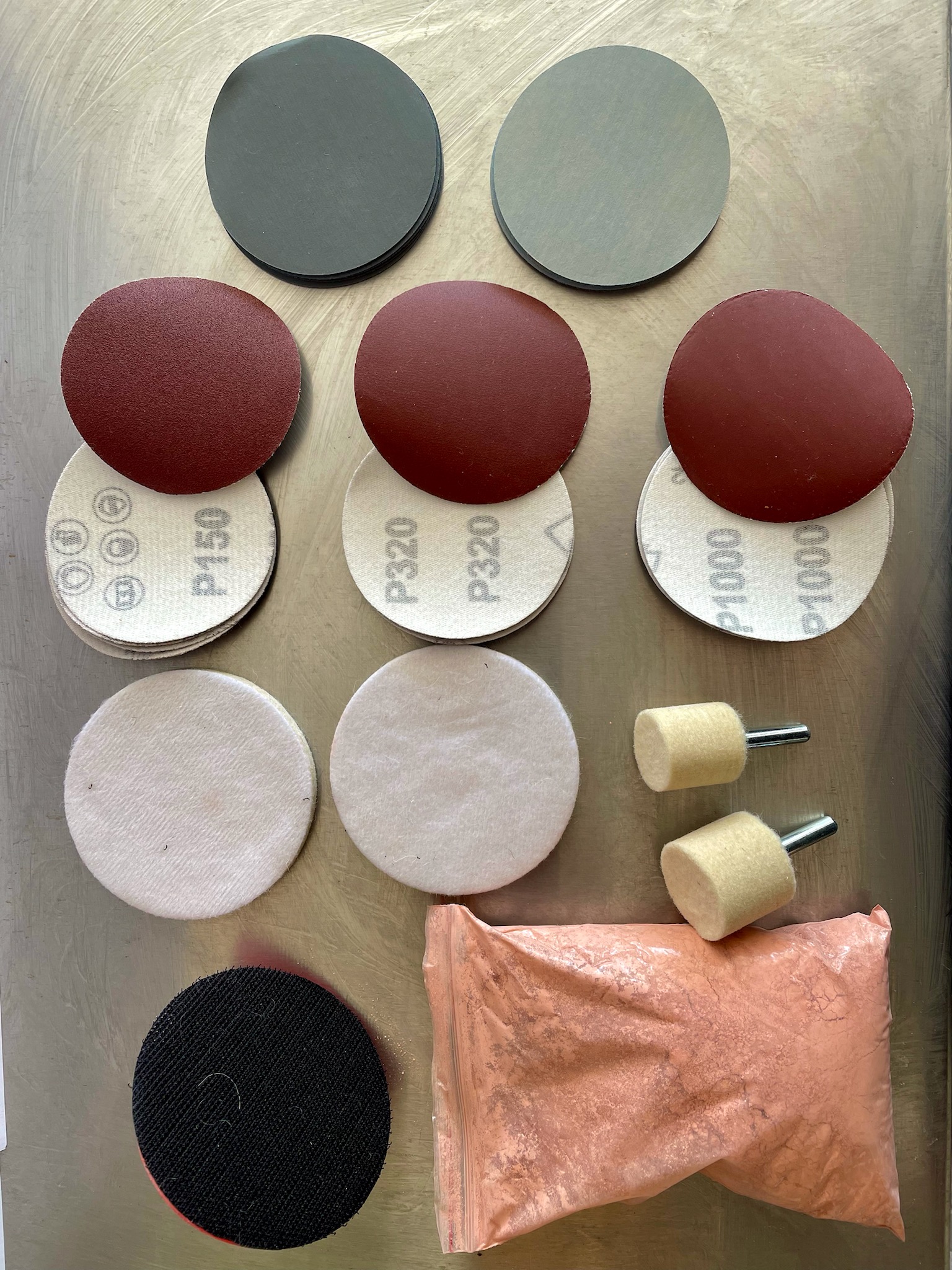With lots of time on my hands to carryout more minor car repairs, I thought of my next task. So, polishing scratched car window glass on the 1969 Riviera was it! This ‘69, before I got out of Warrnambool last year, was on a farm, a lot of its life in Victoria’s Allensford area primarily hauling a horse float to the racetrack over dirt access roads that kicked up lots of rocks, dirt and fine dust and hence it has lots of dirt hiding everywhere.
After some Google research, I initially tried some plain toothpaste and baking powder with hand rubbing 0000 steel wool. I found it slow and wanted to remove those deep scratches faster by planarization (or “Chemical Mechanical Polishing), a process of smoothing surfaces with the combination of chemical etching and mechanical abrasive forces. I came up with a better method. I bought off eBay a Cerium Oxide, chemical formula Ce O2, based glass polish kit. You can buy them in various size kits from – my first trial pack was a 32 piece kit for watch (8 piece smallest) face scratches – to my second pack of 45 pieces (including another Velcro mounted drill shank, felt pads, 5 grades of sanding pads from P150 coarse to P7000 and 8ozs of Ce O2) for windscreens that will let me do 3 or 4 windows and attempt the front windscreen too.
In case there were any small stones and dirt impregnated into the exterior window rubbers, I had folded a sheet of coarse emery paper so that the emery rubbed the edges of the rubber and the smooth paper back didn’t scratch the glass and preventing further scratches. I also made a sheet-metal splashguard to protect the stainless steel door trim from the spinning Velcro mounting disc. It would have been better to lay the windows down flat and polish but I did them in position.
So, away we go, cover the car with drop sheets and/or paper and masking tape, starting with the coarse P150 grit micro fiber disc attached to a 3” rotary polisher, I bought especially for this job, to take out the deepest scratches, followed by a succession of finer discs down to P2000, P3000 & P7000. These fine discs are like wet and dry paper so I used a fine spray of water regularly, being cautious not to overheat the glass. Then use the Cerium Oxide watered down paste on the felt disc, with plenty of wiping off the dried paste to inspect for areas still needing more polishing. The Ce O2 does make a mess as it sprays off the spinning disc, and dries out at high speed settings so add more water, to prevent glass toughening or cracking. I spent four days hard at it with more to come. I eventually found out that a slower speed is less messy and a better result.
The passenger’s side window looked good after six hours work (10am till 5pm – minus time off for lunch etc.). But cutting those deep scratches, left vertical wavy and a hazy effect when viewing the window at an angle, and not all the fine circular scratches had come out that I put into the glass with the rotary polisher on high speed. An LED torch came with the polisher that lets you see residual small scratches better than the naked eye. Going too fast with the discs I might have overheated the glass making the glass surface hard, and therefore harder for the Ce O2 to remove those extra fine swirl marks. I progressed along with the two rear quarter windows and got most of these scratches out and again was happy with the results, the glass feels as smooth as a baby’s bum and improves the glasses clarity.
So, after using that first small batch on three windows, I ordered that second larger 45 piece kit to redo that passenger side window and do the driver’s window, hopefully now perfecting a cross hatch up/down and side to side pattern to even out the high spots and hollows. The fourth window proved to be a harder task requiring more fine discs to remove fine small scratches, and like the windscreen, this window also has stone chips in it. You can also just buy the Ce O2 separately in larger quantities (approx. $65/kg tub) but you don’t get all the Velcro backing pads and discs you might need.
A lot of effort but I have all the time in the world now fully retired. It’s cheaper than (a new windscreen still might be necessary due to stone chips) four new windows, at $60 for the two kits and $99 for a 3” polisher, so far, and my labour is free. And I get my exercise guiding the polisher over all those windows. Another job done and the ‘69 soon to be “On the Road Again!”
- See my liaising report in the October magazine: on another Embassy Gold ‘69 Riv in Hobart, that came up for sale on Gumtree.
Cerium Oxide = Ce O2 (Opticians Rouge)
Cerite (Cerium) is found in its raw state as a soft ductile silvery white metal that tarnishes when exposed to air and is soft enough to cut with a knife. It is commonly found and mined in India; Brazil; South California and China. Cerium is a combination 17 Rare Earth Elements in the Lanthanide silicate group. REE are more common than Lead.
Ce O2 is extracted by refining, that produces an (soluble) oxide for polishing. Also used in catalytic converters in cars as well as refining crude oil.
Ce O2 is non toxic and non irritant to skin.
Other extracted REE’s are important in manufacturing of high quality products e.g.
¨ Preseoymium to create stronger metals for use in aircraft engines.
¨ Cadolinium in Xray and MRI scanning systems and television screens.
¨ Neodymium in power full magnets.
¨ Lanthanium in camera lenses; studio lighting and cinema projectors.
¨ Yttrium; Terbium; Europium in visual display devices such as computer screens.
China is the dominant producer of Rare Earth Elements with 95% of production due to large deposits and low labour costs. The cost of putting together an REE mine include drilling, blasting and hauling etc, can cost billions of dollars and as the methods of separation of the elements include Fractional Crystallization, Ion Exchange, Liquid-Liquid Extraction (partitioning) or Solvent Extraction, requires a lot of processing.
by Gary Ferrett

